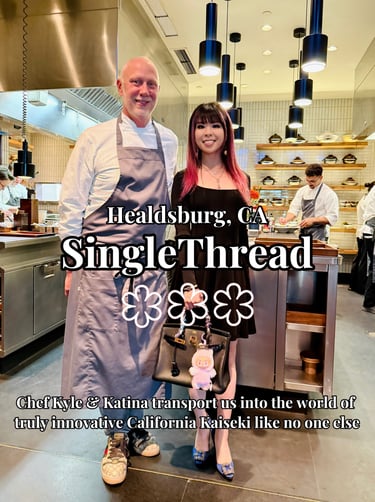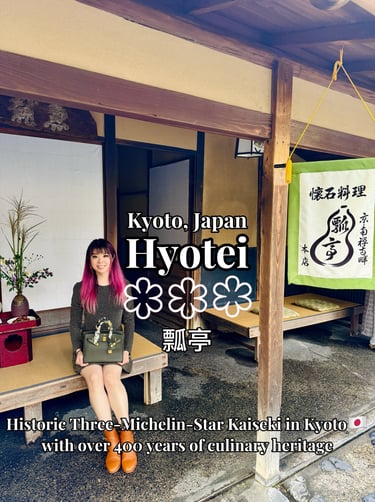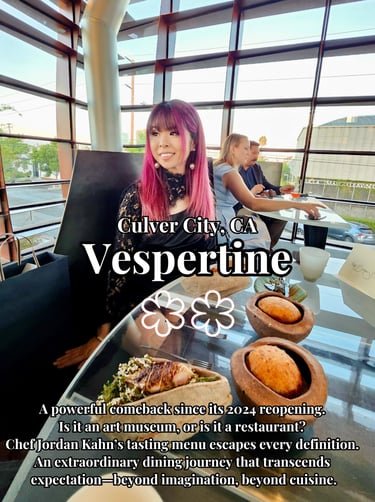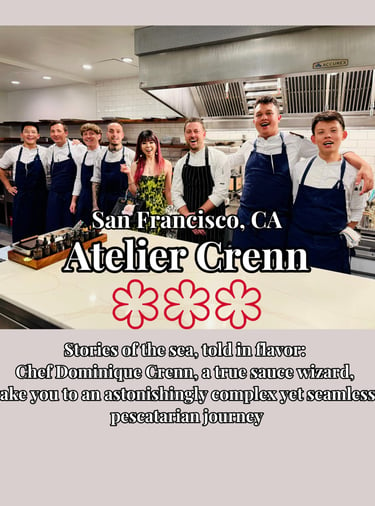Three-Star Somni: A Japanese Enthusiast’s Take on Chef Zabala’s 20-plus courses
MICHELINFEATURED
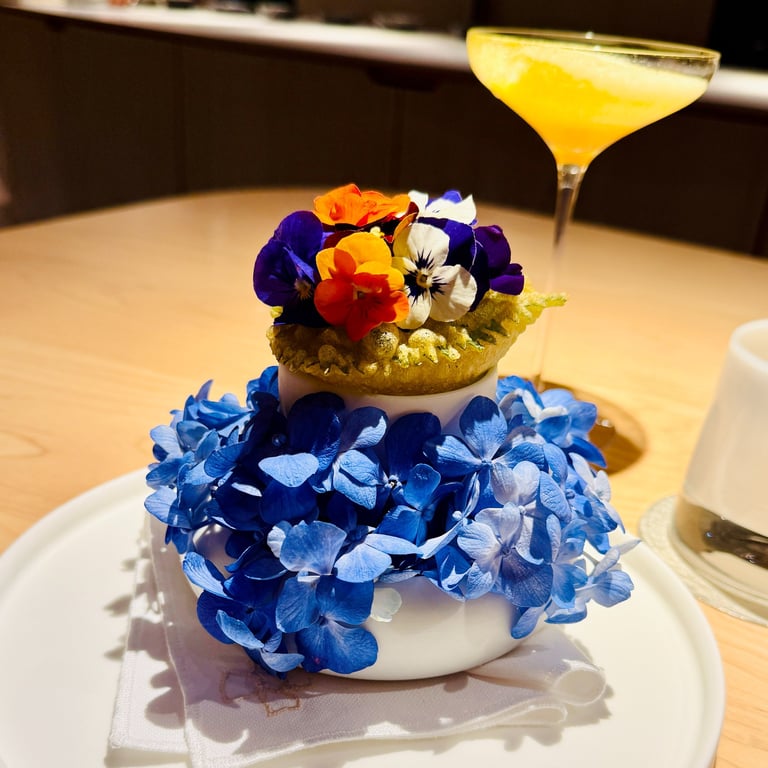

Somni's edible art "Shiso puff tartare" (Photo by Junko Y.)
What is it about Somni that makes it so elusive to describe? This newly crowned three-Michelin-starred sanctuary of creativity stands apart from everything else I’ve encountered in my fine dining journey. Did it really happen? The experience felt as surreal as its name—Somni, meaning “dream” in Catalan—and even now, I find myself floating in the afterglow of that dream.
Reborn just eleven months ago in Los Angeles, this reincarnation of Somni carries forward the legacy of the original two-Michelin-starred version that closed in 2020. Globally renowned Chef José Andrés, under whose restaurant empire Chef Aitor Zabala once served as creative director, first conceived Somni as an intimate project. While Andrés co-helmed the first version, the reopened Somni now embodies Chef Zabala’s independent vision.
Over more than twenty extraordinary courses, each presentation unfolds like an edible art—refined, elegant, and playfully inventive. Yet what lingers is not just the taste; the feeling. From the moment I entered its discreet entrance, I sensed a transition into another dimension—a place where gastronomy meets immersive theater. The softly lit courtyard, adorned with floating, cloud-like art pieces, conjured the warmth of a Spanish evening staged for an audience. The kitchen moved in near-silent choreography: graceful, synchronized, structured. Every gesture carried intention; every detail, seamless.
How does one capture four hours of sensory Alice-in-Wonderland? Somni is more than a restaurant—it is a dreamscape. A place where fine dining meets performance art, where sophistication meets intimacy, and where the boundary between guest and kitchen gently dissolves into genuine connection.


Somni's courtyard (Photo by Junko Y.)
The Welcome Sequence
Once escorted to the courtyard, I was welcomed with a non-alcoholic cocktail, Guisant-ito—a playful nod to guisante (Spanish for “pea”) and mojito. Such a refreshing start—crisp and vegetal—especially after a long drive through the wild LA traffic.
The first bite, a savory Beet meringue, gently set the tone for the evening. A delicate puff filled with creamy Camembert—so fragile it almost dissolved before fully reaching my palate. It reshaped my idea of meringue. Coming from Japan, where I’m intimately familiar with the structure and ingredients of kaiseki, this was a delightful surprise—so airy yet rich and creamy—a sweet technique with savory depth.
Then came “Tigre,” a reinterpretation of a classic Barcelona bar snack. Inside a mussel shell, a silken mussel béchamel, topped with tiny edible flowers arranged with surgical precision. Fried almond added an unexpected crunch—whimsical, fun, delicate, and texturally alive.

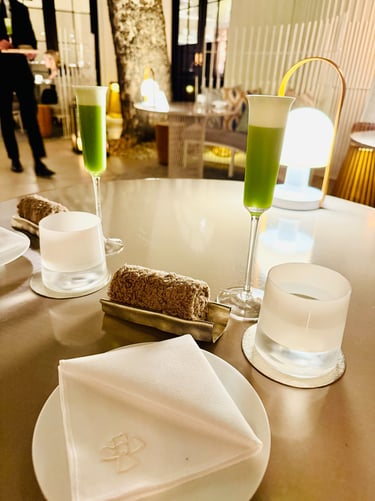
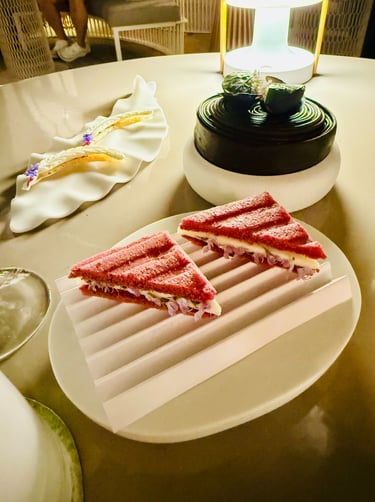

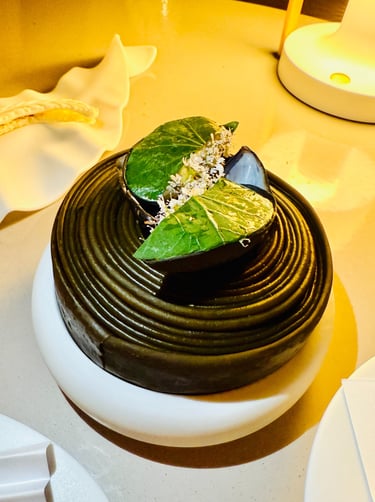

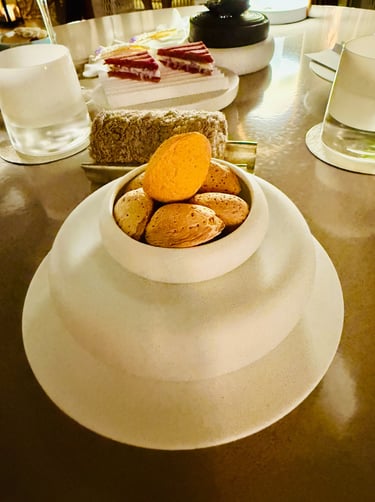

Guisant-ito (Photo by Junko Y.)
Beet meringue (Photo by Junko Y.)
"Tigre” (Photo by Junko Y.)
Fried almond (Photo by Junko Y.)
The Parmesan feather, piped with breathtaking finesse, was pure poetry—an ethereal decoration of Parmesan cream. Beyond its sculptural beauty, the taste was remarkable: an elegant fusion of deep cheese aroma and crisp cracker.
Just as my mind had drifted far from my Japanese roots, I was gently brought back with a Japanese Iwashi bite, Sardine. The fish was layered atop a fish-shaped cracker and adorned with tiny flowers. How fun. The familiar, bold oceanic flavor bloomed—a taste of home amid this Spanish dreamscape.
My favorite from this opening act was Trufflcini. Matsutake, for a Japanese diner like myself, carries profound seasonal resonance—the crisp air of autumn, fleeting beauty of seasonal abundance, and my mother’s matsutake gohan. Pairing matsutake with truffle felt almost audacious—two aromatic “kings” sharing the same stage. Yet Chef Zabala brought them together with remarkable finesse—earthy, fragrant, and artfully balanced. The matsutake flavor, though more understated than what I wished for, carried a quiet elegance—a personal, considered interpretation of the ingredient.
Through these seven opening creations, Chef Zabala set the tone for what Somni’s tasting menu embodies: an experience where imagination, art, culture, seasonal ingredients, and craftsmanship intertwine seamlessly.
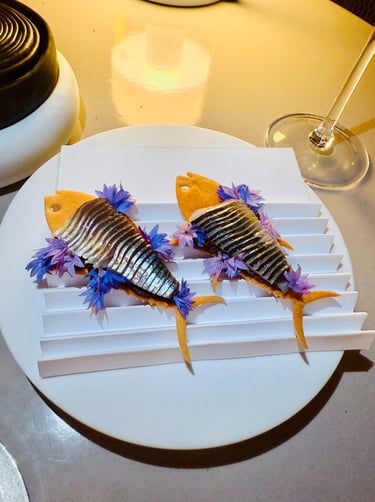

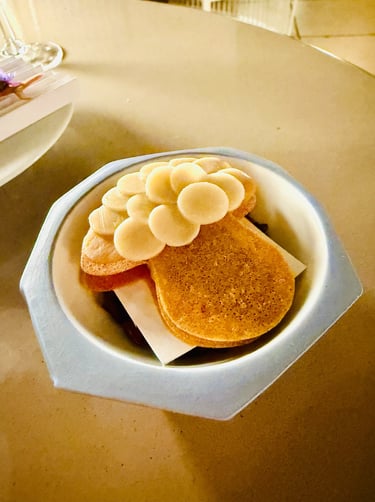



Parmesan feather (Photo by Junko Y.)
Sardine (Photo by Junko Y.)
Trufflcini (Photo by Junko Y.)
The Ambiance of the Dining Room
After the opening act, guests are invited into a sleek, contemporary dining room. My eyes were immediately drawn to the pastel-hued cow and goat heads on the wall—playful yet artful, as if stepping into a private collector’s home. Only fourteen guests are seated each evening, side by side along two slightly curved tables facing the open cooking table. The setup evokes an intimate, modern art showcase, where the artistry unfolds in real time.
What truly impressed me was the ingenious lighting design. Each seat is illuminated by its own pendant, creating the effect of a personal spotlight. Every dish, when placed in front of you, appears as if it’s on stage—perfectly lit, elegantly framed. The light strikes the elusive balance where food looks vibrant and naturally photogenic. In today’s world—where guests often capture and share each course on social media—this consideration feels especially relevant. Many fine dining rooms lean toward dramatic, low-lit atmospheres, making photos dark or muted. Here, however, each plate glows, celebrating both its artistry and its visual storytelling. Collectively, these details evoke a modern museum—every element intentional, artful, and quietly dramatic. This design not only enhances the dining experience but also embraces the reality of how we connect with food today—through shared images, moments, and stories.
As the chefs prepared each course at the open table—lit with the same focused lighting, I felt fully present in the moment, as if the boundary between guests and kitchen had dissolved. What unfolded before me was a living performance. Every movement was deliberate: a chef placing a micro-flower with tweezers, another synchronizing the pace of plating with silent precision. Watching this live choreography deepened my appreciation for the craft behind every creation. It was immersive theater: culinary artistry executed with impeccable timing and design.

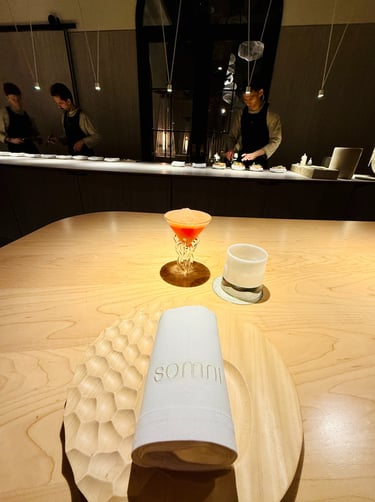
Somni's Table View (Photo by Junko Y.)
The Main Savory Sequence
A defining feature of Somni is its beverage pairings. Guests may choose from five options, from the Non-Alcoholic Beverage Progression to the Premium “Seny i Rauxa” Wine Pairing. I selected the Non-Alcoholic Beverage Progression. A quiet yet deliberate message—that beverages here are not an afterthought, but an integral part of the menu—immediately intrigued me. Every sip is crafted to complement the food—a thrill of anticipation for someone familiar with pairing Japanese teas but encountering a fully non-alcoholic progression for the first time.
While I was absorbing the stylish ambiance of the dining room, my first drink arrived: Sangre de Tomate—a vibrant creation of tomato espuma and celery salt. Its elegant, fresh, pungent tomato flavor spread pleasantly across the palate, introducing tomato as a recurring protagonist of the evening.
The first dish, “Pizza Margherita,” appeared under the spotlight. It resembled a slice of pizza with a browned edge—yet the “crust” was in fact a delicate meringue with a surprising toasty flavor. Topped with caviar, basil leaves, and a sweet, balanced tomato sauce that harmonized with burrata, it evoked the comfort of a Margherita pizza in an utterly unexpected form. The use of fragile meringue was a clever juxtaposition to the opening bite, and also echoed a meringue truffle sandwich I once tasted at é by José Andrés, a nostalgic and playful nod to Chef Zabala’s creative lineage.
Gazpacho “blanco” followed, showcasing two Spanish dishes—ajo blanco and gazpacho. What appeared before me, however, was more artful than expected: marinated, peeled tomatoes resting in a light broth, framed by tomato vines. Expecting the bold flavors of traditional gazpacho, the freshness—light, natural, and subtly perfumed with lemongrass and olive oil—surprised me. It tasted like an exotic, sunlit summer. Frozen white almonds added a delightful crunch, alongside hints of cucumber and raw, grassy notes without bitterness. Using the same tomatoes from the prior courses created a thoughtful progression—a narrative through flavor.
Then came Coco crab, a composition of king crab brightened with pomelo for a citrusy lift, enveloped in coconut milk foam made from crab shells and heads. The foam was rich and aromatic, yet airy in texture, carrying the sweetness and brininess of the crab. A mild, nutty vegetable paste (perhaps kohlrabi) on the side grounded the flavors. Each bite offered waves of sensation—smooth, dense, airy, and textural, as if layers of complexity kept unfolding and amusing the palate. Presentation was striking: a harmony of ocean and land, dotted with tiny purple flowers beneath the foam “sea.” One of my favorites: it revealed new details with every mouthful.


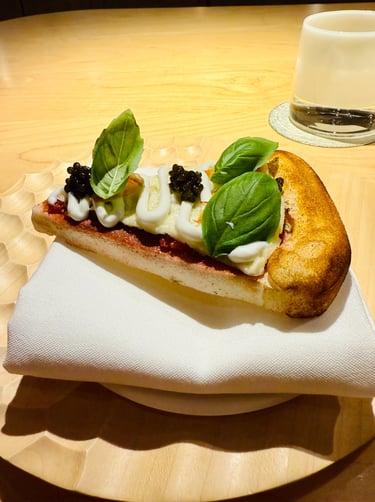

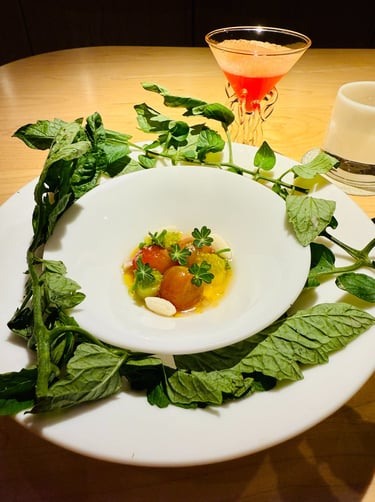


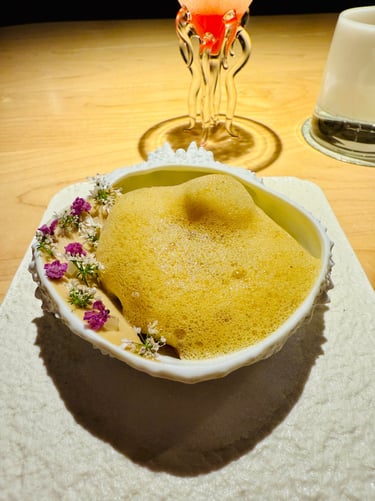
Sangre de Tomate (Photo by Junko Y.)
"Pizza Margherita” (Photo by Junko Y.)
Gazpacho “blanco” (Photo by Junko Y.)
Coco crab (Photo by Junko Y.)
The next drink arrived, The Passion, a non-alcoholic blend of passion fruit and Jack Daniel’s oak chips. It quickly became one of my favorites. Smooth and tropical, it captured the brightness of passion fruit but with remarkable restraint: no sugary sweetness, just refined balance and a whisper of smokiness. Rich, but never heavy.
Then came a dish; I believe the chef introduced it as Mar y Montaña—Tuna & spruce tip. It took my breath away before I even tasted it: a visual symphony crowned with a generous layer of Kaluga caviar, dotted with tiny shiso blossoms, delicate white flowers, and vivid Chanel-red fire sticks, each one meticulously trimmed and arranged. Visual extravaganza. Beneath this exquisite surface was a tartare of chutoro tuna and rosemary-infused bone marrow, served alongside a crisp cauliflower cracker. The first bite offered subtle shiso notes that lit the lush combination of caviar and chutoro. Despite its visual drama, the flavor remained elegant and poised—complex yet light and calm. Placed early in the tasting sequence, a deliberate act of restraint—a prelude rather than a crescendo.
Next came Mejillones escabeche as a mosaic of thinly sliced mussels surrounded by bright yellow petals. Then, a chef approached and completed the dish with a delicate foam made from mussel shells infused with dashi. The mussels were cooked with pastis and topped with a gel made from peppercorn, then finished with a chicken escabeche—a roasted chicken sauce enriched with garlic and vinegar. The flavors carried a sense of continuity from the previous course: light yet oceanic, layered with a citrusy freshness that lingered after each bite.
The next dish, Shiso puff tartare, appeared under the spotlight like a queen on stage—an art piece made of vivid edible flowers arranged with exacting precision. The composition was delicate and ephemeral; the interplay between the smooth, meaty tartare and the thin, crisp shell was remarkably sophisticated. As a Japanese diner, shiso has been part of my life—woven into daily home dishes, often as a supporting role rather than the star. Here, the kitchen transformed shiso into a delicate tempura puff, enclosing rich beef tartare inside. I wished for just a touch more of that raw, herbal shiso brightness, but I was deeply moved by how skillfully Chef Zabala reimagined it—turning my familiar leaf into something truly extraordinary.
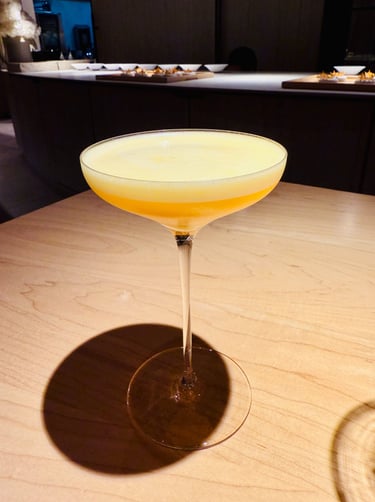

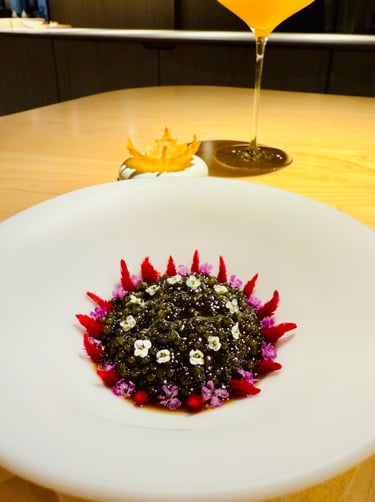

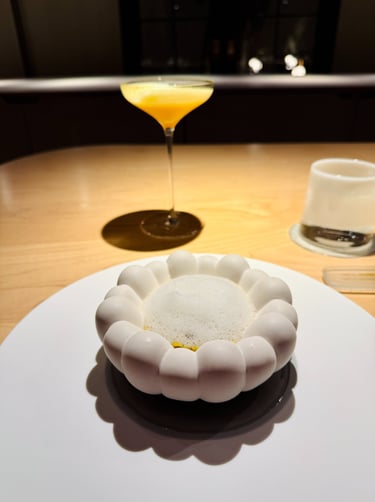

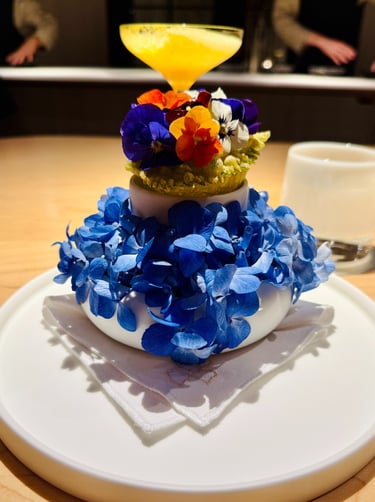

The Passion (Photo by Junko Y.)
Tuna & spruce tip (Photo by Junko Y.)
Mejillones escabeche (Photo by Junko Y.)
Shiso puff tartare (Photo by Junko Y.)
The third drink, Hot & Cold, combined raspberry, elderflower, and a non-alcoholic gin. Its appearance mirrored its name. The bottom layer, a vivid hot pink, was a chilled raspberry base; the top was a velvety white elderflower foam. With the first sip, the contrast between the two temperatures revealed itself—an unexpected play on sensation.
After the hot-and-cold interlude, a dish named Ama ebi (meaning “sweet shrimp” in Japanese) arrived. Served in a cup rather than on a plate, a bright yellow jelly crowned the surface, a striking visual departure from the ravioli we might expect. The dish featured spot prawns, trout roe, and, if I heard correctly, kombu, all topped with a luxurious corn sabayon. At its center was an “egg yolk” ravioli—jelly-like translucent and softly elastic—filled with huitlacoche, the prized corn fungus often used in Mexican cuisine. Here at Somni, it was transformed into a silken purée, seamlessly infused into the ravioli. On the side, a slice of blue corn sourdough replaced the expected tortilla—a clever California reinterpretation of Mexican tradition. It was crisp and nutty, giving way to an elegantly chewy center that echoed the flavor of blue corn. Chef Zabala’s ability to weave Mexican ingredients into a form as European as ravioli—and pair it with sourdough instead of a tortilla—spoke to his unique California flair. Beneath the sabayon’s richness, the ama ebi and trout ikura waited: collectively so buttery, creamy, with a subtle roastiness reminiscent of roasted bacon. The textures—smooth, bouncy, and playfully popping—unfolded in sequence, leaving a lingering sense that this dish marked a turning point in the evening’s journey.
The next dish, Spanish turbot, highlighted Somni’s quiet commitment to sustainability. The fish, dry-aged for five days, was cooked with smoky, aromatic Viking salt and served with snap peas and caviar, then finished with a consommé made from the fish’s head and skin, delicately infused with mint. The turbot was flawlessly cooked—fluffy and tender within—yet despite its fragile texture, it maintained a perfectly crisp, square form. Being Japanese and familiar with turbot in many expressions, I found this to be one of the most exquisite renditions I’ve tasted. The sweetness of the peas and the oceanic aroma of the caviar met in perfect harmony, while the pea’s gentle crunch added playful texture. The consommé was refined and elegant, deepening the flavor with a clean, aromatic finish. This course connected back to the welcome drink: it had been made with the shells of those peas. The kitchen also roasted the fish’s head, bones, and skin to craft the consommé—an expression of both culinary precision and thoughtful efficiency.
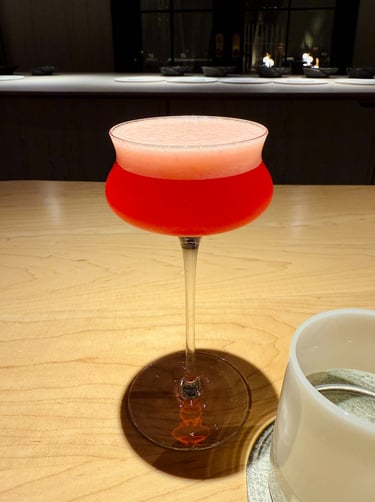

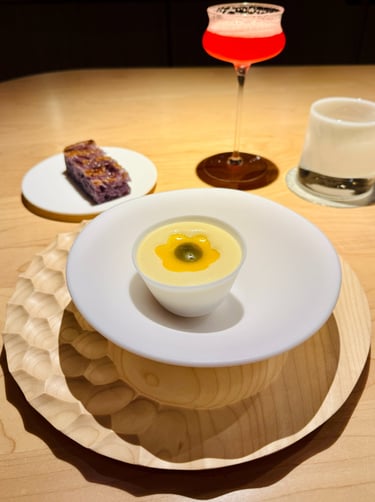



Hot & Cold (Photo by Junko Y.)
Ama ebi (Photo by Junko Y.)
Spanish turbot (Photo by Junko Y.)
The next drink, WEHO, became another favorite—an expressive blend of apple water, maple, and toasted hazelnut. With just one sip, it evoked the essence of fall: subtly spiced, gently sweet, and elegantly layered.
Paired with it was Engawa—a Japanese term for the thin fin muscle of a flatfish, typically served as sushi. This dish extended the narrative from the previous turbot course. I had always associated engawa with a certain chewiness, yet here it was surprisingly tender, bathed in a refined, original teriyaki glaze and accented with shiso blossoms. On the side, a crisp bite of fried fish skin offered a playful counterpoint—crunchy as senbei, fragrant with toasty notes, and brightened by yuzu. These two small bites showcased Chef Zabala’s remarkable versatility and precision.
Then arrived Sparkling Grenade, a lively mix of pomegranate, Earl Grey, elderberry, and club soda. Its tart effervescence deftly reset the palate for the next course: the Oxtail bun. Presented as the restaurant’s bread service, the warm bun arrived with a curry sauce and black garlic paste (perhaps with a hint of ginger) garnished with cilantro blossoms and micro cilantro. The concept was undeniably clever, though for me, it carried nostalgic echoes of the nikuman I grew up eating in Japan: fluffy steamed buns filled with juicy pork. Naturally, this version was far more intricate, yet I still longed for that same comforting pillowy, airy texture and moist, flavorful filling. The oxtail filling was delicate and modest, while the bold black garlic spread slightly overpowered its subtle savor. The lighter curry accompaniment, however, struck a pleasing harmony. The dish certainly acted as a pause and a quiet anticipation before the rich finale of the savory courses.
The finale of the savory dishes was Iberico pork—a stunning presentation of secreto ibérico, the hidden part from the shoulder of the prized Iberian pig. Its marbling evoked that of fine wagyu. A delicate line of caramelized onion purée traced the plate, accompanied by artichoke, a translucent jelly bean made from Ibérico stock, chanterelles, and yuba—a Japanese term for the delicate skin formed from gently heated soy milk. A cream of chanterelle and matsutake mushrooms, echoing one of the opening bites, anchored the composition. Finally, a chef approached each guest to pour the finishing touch: Ibérico pork jus (made from the ribs) enriched with a dot of Roncal cheese. The pork itself was exceptional—deeply flavorful and capable of standing alone—but the jus added depth, enhancing the natural pork umami. The cream, richer and more assertive, introduced a bold contrast, though for my Japanese palate, its intensity slightly overshadowed the pork’s nuance and the distinctive perfume of matsutake. Still, the dish’s duality was masterful—a study in contrast between the familiar Ibérico ham and Chef Zabala’s own beautiful interpretation of its marbled flesh.
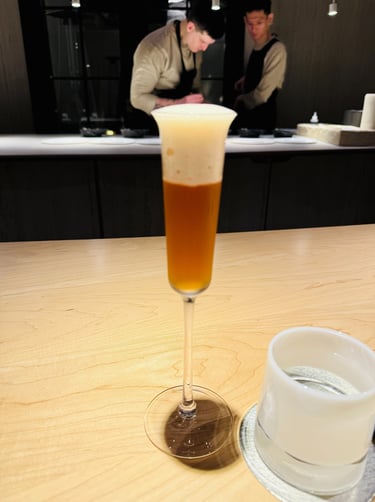


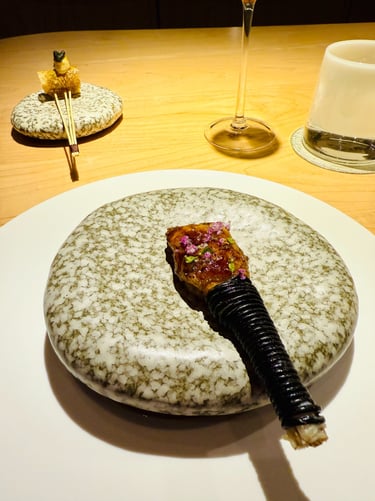
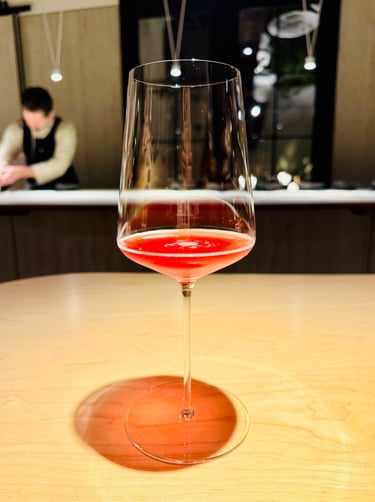

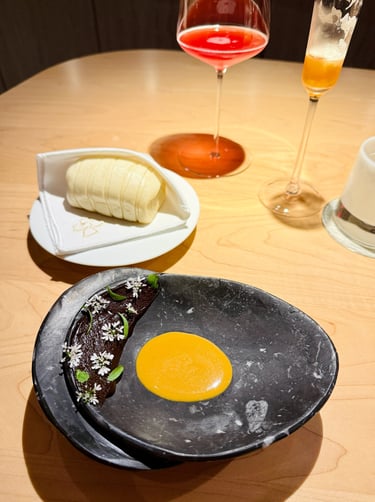

WEHO (Photo by Junko Y.)
Engawa (Photo by Junko Y.)
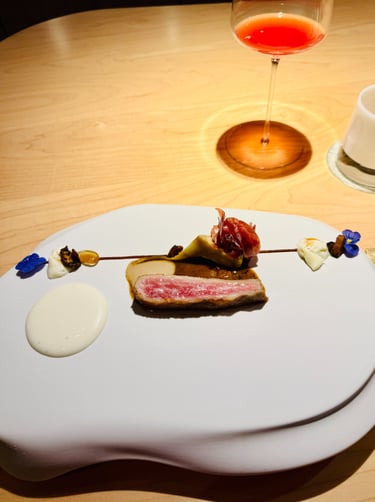

Sparkling Grenade (Photo by Junko Y.)
Oxtail bun (Photo by Junko Y.)
Iberico pork (Photo by Junko Y.)
The Cheese and Desserts
The cheese course, titled “Cow and her milk,” arrived as a playful prelude to dessert. At its base was Brillat-Savarin—rich and buttery—layered with compressed apples, hazelnut praline, and toasted hazelnuts. Though most guests were comfortably full, the dish’s airy creaminess, lifted by the freshness of apple and gentle warmth of roasted hazelnuts, made it unexpectedly light and gratifying. Richly cheesy, yet never heavy, it achieved a clever balance of indulgence and restraint.
Then came Melba. As the plate was set before us, a soft chorus of wows rippled through the room, mine included. It looked like an edible jewel box, with glimmers of ruby red and golden yellow catching the light. Somni’s interpretation of the classic peach melba began with silky, elegantly sweet amaretto cream at the base, topped with raspberry ice cream and a delicate white miso crumble. The raspberry’s flavor was beautifully measured—gentle rather than tart, soft rather than sharp—and it harmonized gracefully with the subtle almond note of the amaretto. A stunning finale to the sweet courses.
The final drink, Cacao “Cola,” blended toasted cocoa nibs, pink peppercorn, and lime—a clever, effervescent bridge between chocolate and spice.
Then came Sweet little things, the petits fours, always one of my favorite moments in fine dining. A bright green sip infused with ginger and shiso flowers opened the sequence, refreshingly herbal. A spoonful of “strawberries and cream” followed—a fragile sphere that burst with liquid the instant they touched the tongue, a joyful surprise. Strawberry and raspberry gummies, lighter in texture than expected, carried vivid fruit flavor. At first glance, the madeleines appeared traditional, but they revealed themselves as chilled, paper-thin shells filled with a silken white chocolate cream. The mochi dumpling had a perfectly supple texture, reminiscent of Kyoto’s refined yatsuhashi. Even the “very L.A.” donuts, as the chef called them, were playful—crisp shells concealing a whisper of cream.
Each bite was elegantly sweet, never cloying. After around twenty courses, this delicately filled interpretation of traditional petits fours was a brilliant conclusion—playful, thoughtful, and perfectly attuned to the diner’s state of fullness.
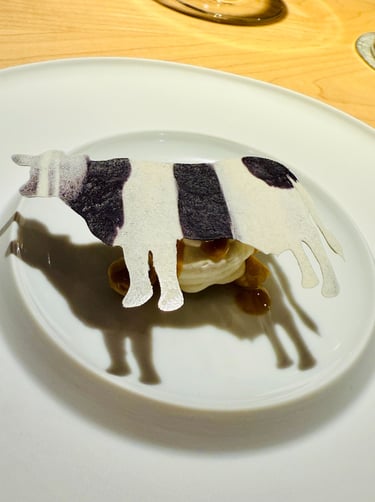

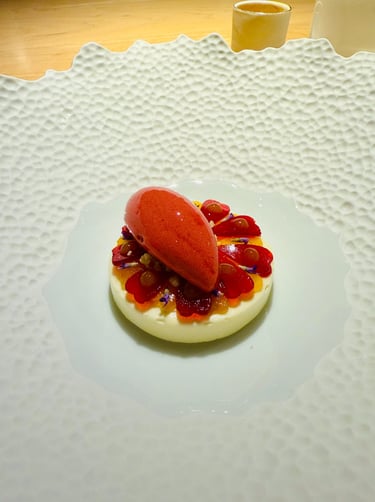

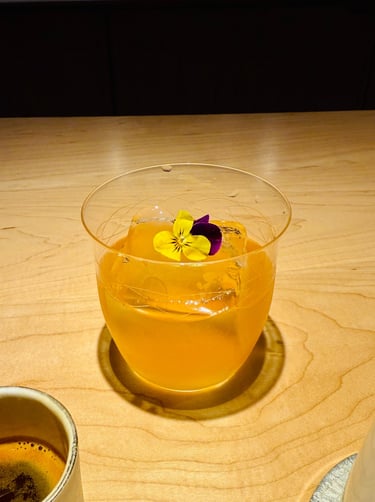

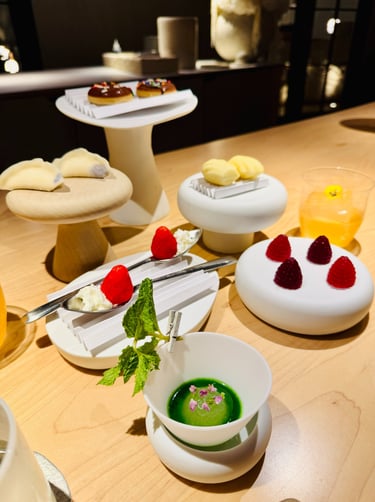

"Cow and her milk” (Photo by Junko Y.)
Melba (Photo by Junko Y.)
Cacao “Cola”(Photo by Junko Y.)
Sweet little things (Photo by Junko Y.)
The Service
Chef Zabala was not in the kitchen that evening: a slight disappointment. Still, the hospitality at Somni was exceptional.
A few moments stood out vividly. When I accidentally changed part of my plate setting, none of the staff made me feel as if I had done something wrong. Precision and presentation clearly matter here, yet instead of correcting me in public, a chef quietly reappeared moments later—almost like a ninja—and gently offered to restore what I had moved. His discretion and kindness passed unnoticed by anyone else, yet it spoke volumes to me. That subtle grace meant a great deal. I’ve had the opposite experience elsewhere, where a public correction felt condescending and humiliating, erasing the joy of the meal entirely. At Somni, I felt respected and genuinely cared for.
Another small but meaningful gesture: my napkin kept slipping off my lap because of my silky dress. Without a sound, a staff member appeared and replaced it with a fresh one, again without drawing attention. These quiet acts of care preserved both comfort and dignity.
Throughout the evening, the staff maintained a perfect balance—never interrupting personal conversations, yet always present with the right amount of professional warmth. I appreciated their initiative in sharing details of each dish, including how it was prepared, which fueled my curiosity and passion for food. My questions were answered with quiet confidence, even by those not in the kitchen, reflecting their deep knowledge and pride in their craft.
After the meal, I had a brief chat with the chefs. Everyone was open, genuine, and unhurried—neither overly formal nor casual. Even as the clock neared midnight, they showed no signs of fatigue and never made me feel rushed. That final moment of friendly conversation left me with a lasting impression—and a desire to return.
The Final Thought
As someone who grew up in Tokyo with a chef father, I didn’t expect such a profound Japanese influence at Somni. I had imagined a contemporary expression of Spanish cuisine through a Californian lens—but what unfolded was far more layered and globally attuned. Few fine dining restaurants at this level integrate this many culinary cultures so seamlessly.
Chef Zabala’s ability to translate his vision into reality is extraordinary. Each dish reflects not only technical mastery but also an openness to global inspiration—Spanish, Japanese, and beyond—merged into a language uniquely his own. The precision and confidence required to balance ingredients and techniques from disparate culinary traditions are astonishing, and he carries it out with painstaking mastery. His depth of knowledge of Spanish and European gastronomy, paired with his sensitivity to Japanese aesthetics and California’s produce-driven rhythm, makes his cuisine stand apart.
Equally remarkable is the warmth and ease of the entire team. Unlike many prestigious Japanese fine dining establishments, where a certain formality creates distance, at Somni, the boundary dissolves. The service is both professional and personal, creating an atmosphere of genuine connection. I felt relaxed, welcomed—almost at home.
Chef Zabala’s multicultural vision—integrating techniques, philosophies, and flavors from around the world without losing focus—beautifully captures what Los Angeles fine dining represents today: creativity, originality, and cultural dialogue at the highest level. Somni’s three Michelin stars are fully deserved; Chef Zabala’s recognition with three knives from The Best Chef Awards feels entirely justified. I would return without hesitation.
Visited: October 9, 2025
